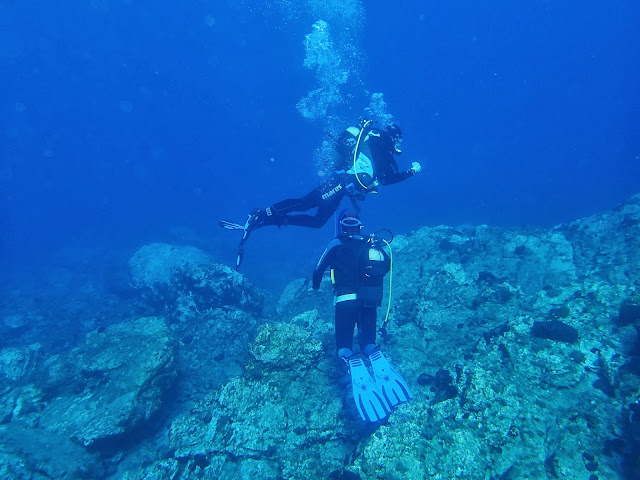 |
| A taxonomic collection of fishes from the Pineos River, Thessaly, Greece* |
December 13th 2013
My colleagues at IMBRIW** in HCMR have for years worked to finish answering this question. Its not easy. And it is important; maybe urgent.
Firstly were talking about "species" - a supposedly solid taxonomic unit; well...it is not that solid!
The concept of species has evolved. And now, following the Phylogenetic Species Concept (contra the Biological Species Concept) a major revision of species entities has expanded. In Europe the 'revolution' crash-hit us when Maurice Kottelat and Jorg Freyhof published their "Handbook of European Freshwater Fish" (2007). This book provided a kind of whole-scale validation for many new species of inland fishes in Europe. All of a sudden we had many many new species (many of them formally known as subspecies). Following the new 'evolutionary' approach to species definition, the notion of sub-species is dead. So even if our country is already famously rich in fish species - what do you do when many of the former entities are split-up with new shiny names?
Now how many in Greece?
In 2007 my colleagues and I published an annotated list and conservatively defined the number as 161 species firmly following Maurice and Jorg. Our paper is not one to purport brevity - so if you do read it you will see that we do point to the controversies the new species concept has created.
The freshwater ichthyofauna of Greece-an update based on a hydrographic basin survey
AN Economou, S Giakoumi, L Vardakas, R Barbieri, M.Th. Stouboudi, S Zogaris
Mediterranean Marine Science 8 (1), 91-166. Available at:http://www.medit-mar-sc.net/index.php/marine/article/view/164
In late 2012 my colleagues and I published an update to the list-paper and the number stood at 167 species.
Recent contributions to the distribution of the freshwater ichthyofauna in Greece
N Koutsikos, S Zogaris, L Vardakas, V Tachos, E Kalogianni, R Sanda, et al..
Mediterranean Marine Science 13 (2), 268-27. Available at: http://www.medit-mar-sc.net/index.php/marine/article/view/308
Now how to keep track?
This is not easy for the following reasons:
a) Several species groups are poorly studied and need to be re-assessed; studies are in the pipeline that will certainly increase the species number where former clinal differences or former subspecies existed. So we expect to see at least another 10 species entities arise in the next decade - this is a conservative estimate I think.
b) Some species are not only created but may be "lumped" into others and re-assessed not as species but as local population units at best. This may be possible but I predict not many such changes will occur. Also the new taxonomic work may show that species that were considered to exist in this country are now proven not to exist since the Greek populations belong to other species. (We did "lose" two species in this way during the last list revision -
Salmo dentex and
Barbus rebeli where subtracted from the Greek fish list!).
c) The problem of marine fishes in fresh waters is important; surely the line is not black-and-white.Already many fish that breed solely in marine waters are included in the freshwater list (grey-mullets and eel for example); and this is commonplace in most country assessments worldwide. Some marine fish are common, widespread and often found in pure freshwater conditions not just the brackish river mouth extremes (a.k.a. transitional waters). Our 2007 estimate guesstimated that at least 55 'marine' species are frequent migrants or transients into fresh waters or transitional waters (river-mouths, coastal marshes etc). So we need to work on criteria to include the most frequent - pervasive marine transients in the inland waters list.
So its at 167. But do note, about 27 of these are non-indigenous species. And the list does not include the many marine transients, or the several "new species" that are being described by taxonomists and are currently still "in progress" or "in press"....
Exciting time to be a fish person in Greece!
I include some pretty snap-shots from just one expedition back in 2011....
 |
| A Cobitid Loach from the Pinios in Thessaly; the population from a spring-fed marsh in Thessaly was called Cobitis stephanidisi (it may be extinct!); this specimen is similar to Cobitis vardarensis. |
 |
| A large Greek Barbel Luciobarbus graecus from a canal entry area of the Kifissos River next to Lake Yliki. This beautiful large-bodied fish (IUCN Endangered) is known to reach up to 110 cm length in the lake. |
 |
| Big taxonomic changes are occurring with the Sprilins (Alburnoides sp) in the Balkans. These specimens are to be soon known as Alburnoides thessalicus - a name formerly attributed to a subspecies. Further south in the Sperchios a new species is now being described! |
 |
| Europe's smallest freshwater fish; the Trichonis Goby Economidichthys trichonis. Known only from Lakes Trichonis and Lysimachia. The unique 'zebra-pattern' is distinctive. |
 |
| The rare Strymon Minnow Phoxinus strymonicus, photographed in a cold-water spring near Drama. This group needs careful study since there may be another species or two in Greece! |
 |
| One of Greece's most famous endemics: Aristotles Catfish Silurus aristotelis. Photographed here in Lake Yliki where it has recently been transplanted (probably) accidentally by carp stocking. |
 |
| One of Europe's rarest fishes, the Greek Stickleback Pungitius hellenicus, is not even mentioned as a "Species of Community Concern" in the Habitats Directive - a law that should protect all rare fishes in Europe. |
* All photos taken during the September 2011 collecting expedition; a collaboration between HCMR and Prague National Museum.
** IMBRIW = Institute of Marine Biological Resources and Inland Waters.



































































